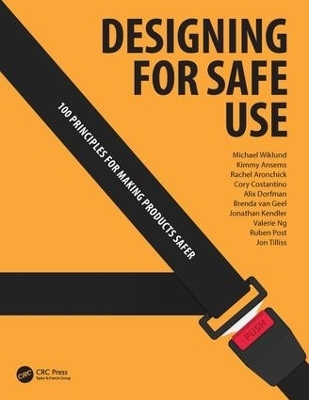
Designing for Safe Use
CRC Press (Verlag)
978-0-367-18831-3 (ISBN)
How do you prevent a critical care nurse from accidentally delivering a morphine overdose to an ill patient? Or ensure that people don't insert their arm into a hydraulic mulcher? And what about enabling trapped airline passengers to escape safely in an emergency?
Product designers and engineers face myriad such questions every day. Failure to answer them correctly can result in product designs that lead to injury or even death due to use error. Historically, designers and engineers have searched for answers by sifting through complicated safety standards or obscure industry guidance documents.
Designing for Safe Use is the first comprehensive source of safety-focused design principles for product developers working in any industry.
Inside you’ll find 100 principles that help ensure safe interactions with products as varied as baby strollers, stepladders, chainsaws, automobiles, apps, medication packaging, and even airliners. You’ll discover how protective features such as blade guards, roll bars, confirmation screens, antimicrobial coatings, and functional groupings can protect against a wide range of dangerous hazards, including sharp edges that can lacerate, top-heavy items that can roll over and crush, fumes that can poison, and small parts that can pose a choking hazard.
Special book features include:
Concise, illustrated descriptions of design principles
Sample product designs that illustrate the book’s guidelines and exemplify best practices
Literature references for readers interested in learning more about specific hazards and protective measures
Statistics on the number of injuries that have arisen in the past due to causes that might be eliminated by applying the principles in the book
Despite its serious subject matter, the book’s friendly tone, surprising anecdotes, bold visuals, and occasional attempts at dry humor will keep you interested in the art and science of making products safer. Whether you read the book cover-to-cover or jump around, the book’s relatable and practical approach will help you learn a lot about making products safe.
Designing for Safe Use is a primer that will spark in readers a strong appreciation for the need to design safety into products. This reference is for designers, engineers, and students who seek a broad knowledge of safe design solutions.
.
Michael Wiklund is an internationally recognized human factors engineering expert with more than 30 years of experience. He has authored several books about designing products for safe, effective, and satisfying use. He serves as general manager of the human factors research and design practice at UL (Underwriters Laboratories), is a professor of the practice at Tufts University, and frequently speaks at industry events focused on safety. Kimmy Ansems holds her master’s and bachelor’s in industrial design from the University of Technology in Eindhoven. She has been practicing human factors engineering for nearly four years within the domain of medical technology. Rachel Aronchick is a certified human factors professional with a master’s in digital media and interactive design from Northeastern University and a bachelor’s in human factors engineering from Tufts University. Rachel has been practicing human factors engineering for more than five years, primarily with a focus on making medical devices safe and usable. Cory Costantino is a certified human factors professional and holds a master’s in human factors in information design from Bentley University. He has taught numerous courses within the field of design at Wentworth Institute of Technology. Cory has been practicing design for almost 20 years in consulting, corporate, and start-up companies across medical and consumer product domains. Alix Dorfman holds her master’s in human factors and applied cognition from George Mason University and her bachelor’s in psychology and economics from Cornell University. She has been practicing human factors engineering for more than five years within the domains of military and medical technology, with a current focus on exoskeletons. Brenda van Geel holds her master’s in design for interaction and her bachelor’s in architecture from Delft University of Technology. She has been practicing human factors engineering and user experience design for three years within the medical technology domain. Jonathan Kendler is a user interface designer and human factors engineer with more than 20 years of experience. He has designed user interfaces for various safety-critical products, including dialysis machines, robotic surgical systems, and infusion pumps. Valerie Ng holds her master’s in fine arts and her human-computer interaction certificate from Tufts University. She has been practicing user experience and user interface design for more than four years within the medical field. Ruben Post holds his PhD in industrial design engineering from Delft University of Technology and is the editor-in-chief of The Magazine for Human Factors in The Netherlands. He has also taught usability, product evaluation, and product perception courses at Delft University of Technology. Ruben has been practicing human factors engineering for three years within the domain of medical device usability. Jon Tilliss is a certified human factors professional with a master’s in digital media and interactive design and a strong foundation in user experience research. He is a part-time lecturer at Tufts University, where he teaches a course on user interface design. Jon has more than 10 years of experience leading cross-functional teams to design and deliver safe and usable solutions that delight users in the medical, healthcare, and telecommunications domains.
Foreword. Imperative to Design Safe Medical Products. Guidelines. Anti-Glare Screen. Anti-Tamper Mechanism. Audible Alarm. Audible Feedback. Audio Pause. Automatic Checks. Backup Power. Brakes. Calculators. Change Confirmation. Checklist. Cognitive Mapping. Color-Coding. Concurrent Display. Confirmation Dialog. Conspicuous Expiration Date. Conspicuous Warning. Control and Display Relationship. Damage Resistance. Data Log. Data Refresh Rate. Date Setting. Decimal Alignment. Directional Cue. Easy Cleaning. Easy Opening Package. Elimination of Pinch Points. Embedded Warnings. Emergency Access. Emergency Stop Control. Evidence of Damage. Field Input Example. Figure-Ground Contrast. Flash Rate. Force Tolerance. Graphical Instruction. Handles. Icon and text Labeling. Information Hierarchy. Information Highlighting. Interoperability. Intuitive Grip. Intuitive Symbols. Large Buttons. Large Decimal Point. Latching Alarms. Legible Text. Limited Assembly Requirements. Limited Overrides. Limited Range of Settings. Mechanical interlock. Mimic Diagram. Misconnection Prevention. Mixing Instructions. Needle Guard. No Trailing Zeros. Non-Reliance on Color. Non-Reliance on Memory. Non-Separable Parts. Numbered Steps. Numeric Pad Layout. Online Help. Operating Mode Indication. Passwords. Practice Mode. Predictive Analysis. Progress Indication. Prompts. Quick Reference Guide. QWERTY Keyboard. Redundant Coding. Resistance to Movement. Rounded Edges. Screen Lock. Shape-Coding. Slip-Resistance. Splash Guard. Stability. Status Indication. Tactile Feedback. Tallman Letters. Text Font. Thermal Insulation. Toggle Ambiguity Avoidance. Torque Limited Motors. Troubleshooting Guidance. Undo Option. Units of Measure. Use of Familiar Language. User Manual Index and Table of Contents. User Pacing. Viewing Angle. Viewing Distance. Visual Alarm. Visual Feedback, Voice Commands. Wireless Device Pairing. Exemplary Products
| Erscheinungsdatum | 13.03.2019 |
|---|---|
| Zusatzinfo | 500 Illustrations, color |
| Verlagsort | London |
| Sprache | englisch |
| Maße | 210 x 280 mm |
| Gewicht | 2500 g |
| Themenwelt | Kunst / Musik / Theater ► Design / Innenarchitektur / Mode |
| Schulbuch / Wörterbuch | |
| Medizin / Pharmazie ► Gesundheitswesen | |
| Technik | |
| ISBN-10 | 0-367-18831-7 / 0367188317 |
| ISBN-13 | 978-0-367-18831-3 / 9780367188313 |
| Zustand | Neuware |
| Haben Sie eine Frage zum Produkt? |
aus dem Bereich


